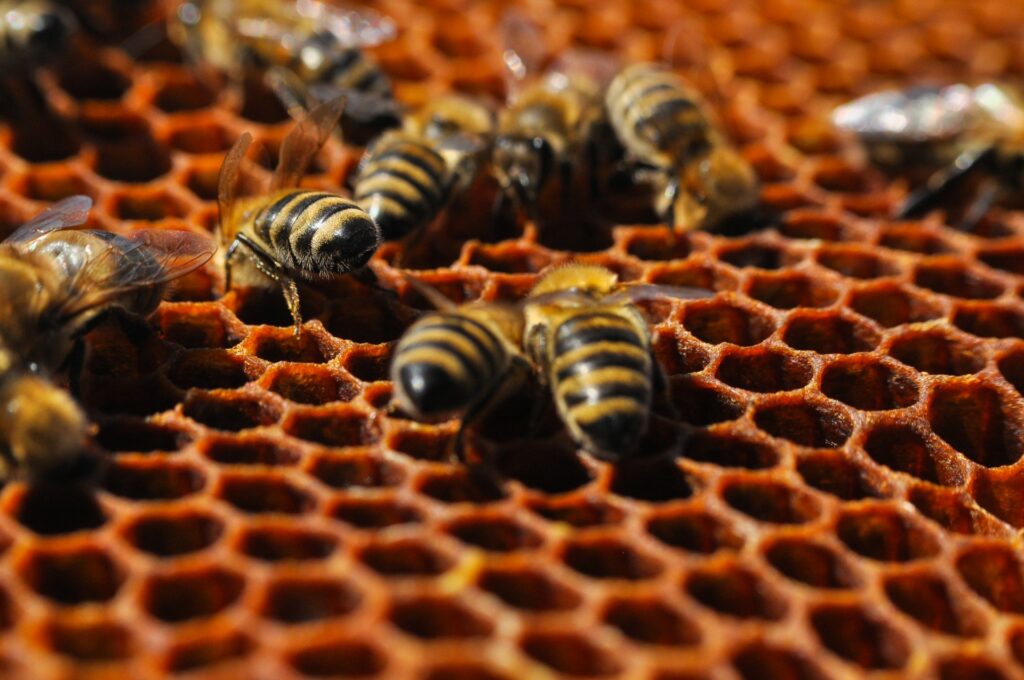Five Things to Know About Dark Beeswax Combs

Often, beekeepers wonder why they have so many beeswax combs that are darker in color and how to use them properly. Questions like, “Can I get honey out of dark beeswax combs?” are commonly asked when facing a darker-than-normal batch of combs. Although some dark beeswax combs can be problematic, there are some unique uses because darker combs are natural and do not make them unusable or dangerous to the bees. The bees use the darkest combs for brood rearing, which are essential!
Beautiful Combs Darken Naturally
New brood combs are beautiful, but like cars, they will lose their luster and glean over time. Darkening combs happen over time and may be hard to detect at first. It may feel like the combs turn dark overnight, but it happens slowly until the tipping point where they are visually darker. This is when the darker color puts off beekeepers, and they wonder if it is safe for the bees.
These darker combs are dirty for a reason, and that is because brood rearing is dirty work. It is comparable to raising infants – stains, dust, grime, and dirt are part of the process and is normal. Even the most meticulous beekeepers can’t avoid darkened combs. Worker bees have dirt on their feet, leaving particles in the hive and honeycombs.
Cocoons Remain and Get Darker Over Time
Cocoons stay in place after the pupa grows and emerges as an adult. The waste also remains and darkens the wax. Wax begins lighter, but as the worker bees prepare for the next round of cells, they clean the surface, but everything stays put. Bees do not remove the cocoon layer, so waste gets locked in but does not harm the new larvae. Some worker bees will add propolis to the cell for added protection, and this is known to darken combs.
Each round of brood rearing adds layers of debris, continuing to make combs darker. Darker combs have provided life to many rounds of brood rearing but still have lots of use for the hive. The combs near the edge often remain cleaner and longer, thanks to the busy nurse bees who typically use the middle of the frame more than the outer edge. So, beekeepers should not be worried when their combs are varying colors within each hive.
Brood Rearing is a Messy Process
As the cells in the comb are filled with an egg, the shell dissolves instead of cracking, and that slimy substance accumulates. The bee larva gets lots of attention, including royal jelly and bee food. As you can imagine, in a busy factory, pollen, and dust splatter and stick to the clear combs and begin to change their color. Then, as the larva spins a cocoon, all its waste is emptied, and that waste becomes part of the cocoon fabric, so it doesn’t affect the developing bee and contaminates the new addition.
How Times Have Changed
Dark combs used to be coveted because their odor was a sure way to attract bees. Bees have incredible olfactory senses, and much of their behavior is driven by what they smell. Older combs have more pungent smells, which makes sense according to their repeated use. Some beekeepers have been known to use combs for over twenty years! As the uses continue, the inside of the cell gets smaller because of the additional layers, and new dangerous pathogens encourage beekeepers to change combs after five years. These new suggestions protect hives from potential dangers carried over too long a period and minimize the pathogen load left in a hive. Replacing darkened combs after five years also prevents the build-up of pesticides bees have brought to the hive. Even trace amounts of pesticides over time can cause harm to baby bees and make them sick. Beekeepers mitigating mites in their hives often use pesticides, and accumulation over time can damage a hive.
Honey and Other Uses for Dark Honeycombs
It is ok to use honey from darker combs. The color has very little to do with taste, and the natural antimicrobials in honey keep it safe to consume. Most of the honey you purchase off the grocery store shelves is likely from older and darker combs.
Using darker honeycombs can be rewarding but takes patience. Using this darker honeycomb in crafts can produce candles that are great for outdoor use. Since darker combs yield little wax, it can take time. However, some beekeepers use dark combs to help start a fire. The melted wax can be mixed with woodchips or spread on paper, then rolled up and used as a firestarter.
Remember, older and darker combs have a strong scent to bees and can help lure bees swarming to a hive. Once bees move in, change out the dark combs with new ones.
If you live in Southern California and have encountered a beehive posing a threat to people or pets, please call D-Tek Bee Removal for safe and humane relocation of hives.
